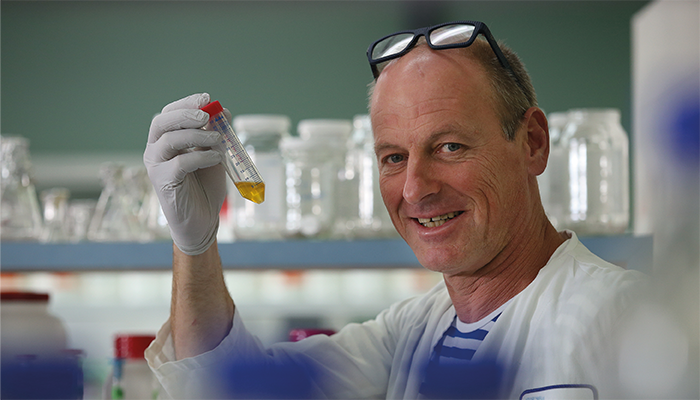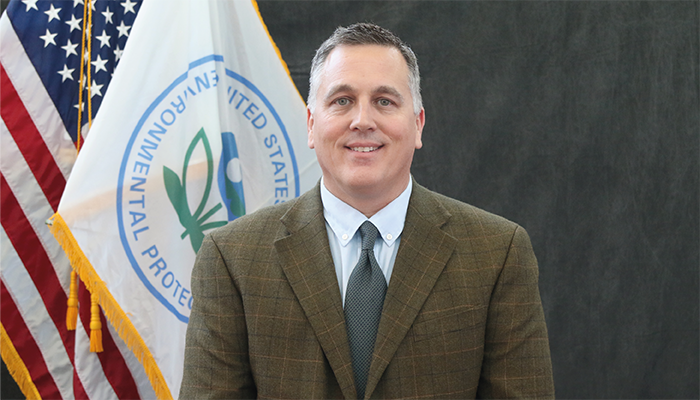Stefan van Leeuwen is Senior scientist at Wageningen Food Safety Research, Wageningen University & Research, Netherlands. First acquainted with PFAS in the early 2000s, Stefan’s work has mainly focused on developing methods to analyze PFAS in food and environmental samples – investigating their presence and impact on food safety within food production systems. He initiated the first global interlaboratory study on PFAS, emphasizing the importance of quality control. Stefan currently co-chairs the PFAS Core Working Group of the European Reference Laboratory on Persistent Organic Pollutants (POPs), aiming to enhance the proficiency of food analysis in European labs.
Richard Jack is Global Market Development Manager in Food and Environmental at Phenomenex. With over 18 years of experience in chromatography and mass spectrometry for environmental, semiconductor, chemical, and pharma applications, Richard has collaborated with global regulatory agencies to develop validated methods through new applications, instrumentation, column chemistries, and software. He’s currently Second Vice Chairman for the ASTM D19 subcommittee on water analysis.

Richard Jack (Credit: Phenomonex)

Stefan van Leeuwen
Jochen Mueller, is Professor at the University of Queensland and Australian Laureate Fellow. He leads a research team that focuses on Exposure Science, including human biomonitoring to understand exposure trends. His research includes PFAS sources, fate, exposure, and treatment. In addition to this, Jochen established the Australian Environmental Specimen Bank.
Mark Strynar is Senior Physical Scientist at the US EPA in Research Triangle Park, NC, USA. During his 20 years as an analytical chemist, Mark has developed analytical methods for the measurement of PFAS and other chemicals in environmental and biological samples.

Jochen Mueller (Credit: The University of Queensland)

Mark Strynar
When did people first become aware of PFAS? And where are they most commonly found?
Stefan van Leeuwen: PFAS – also known as “forever chemicals” – have been around for some time, but only reached scientists’ radars in the late 1900s/early 2000s, when studies reported on the two major PFAS compounds (PFOS and PFOA) in the environment. The general public in Europe gained awareness more recently – since the late 2010s, when hot spots were detected and studies reported on the occurrence of PFAS in consumer products, such as food and drinking water. These reports in the media are threatening the public’s sense of safety. From a food perspective, the European Commission (EC) has introduced legislative measures (limit values) for some foods – an important step in reducing PFAS exposure. However, with the potential of hundreds to thousands of other PFAS in the environment, there may be other compounds that need our attention.
Mark Strynar: PFAS have been used for decades in a multitude of commercial and consumer product applications. Their unique chemical and physical properties make them candidates for use in many applications – for example, firefighting foams, fluoropolymer production, stain resistant coatings. Though the knowledge of individual and broader class PFAS continues to grow, there is much that remains unknown about these compounds.
One such area lacking information is what is/has been produced and released into the environment. Analysis of environmental samples using high-resolution mass spectrometry and non-targeted analysis applications has been very fruitful in identifying new and emerging PFAS. For most organic environmental contaminants, the characteristics of persistence, bioaccumulation potential, and toxicity (PBT) cause concern. A select number of PFAS satisfy all three PBT concerns, while for other PFAS, PBT concerns are either partially satisfied or are completely unknown.
Due to press coverage, there is growing knowledge on this topic within the non-scientific community. However, there remains much to understand about PFAS occurrence, risk, and remediation. Learning more about which chemicals we are dealing with is the very foundation of this research. Without this knowledge, the study topics mentioned above cannot commence.
Jochen Mueller: One of the main uses of PFAS that has led to a particular contamination has been in aqueous film forming foams (AFFFs). Open release of AFFF, particularly during regular firefighting training, has led to contamination of soil, groundwater, and human exposure in Australia and across the world. Both firefighters and the wider community have faced elevated levels of PFAS in blood, potential health effects, economic losses, and broader societal impacts.
Richard Jack: As Mark alluded to, PFAS are used everywhere, requiring a multi-faceted approach. It’s also key to understand the goal of our analysis – are we simply measuring them, developing new products, trying to understand their toxicology, or looking for better ways to remove PFAS? It’s important to pursue all of these goals to protect the public.
Which techniques are at the forefront of PFAS analysis?
Mueller: There are so many methods that have a role in PFAS analysis. Of course, we routinely use liquid chromatography mass spectrometry (LC-MS/MS) for the main bulk of target PFAS analysis and liquid chromatography-high resolution MS for suspect screening and discovery. IC-MS is employed for short chain compounds like TFA and GC-HRMS is used for some volatiles. DESI-MS can be very useful for “2D” visualizing PFAS in niche applications, and DART-MS is used for surface desorption work. There is also space for FTICR and NMR for identifying new PFAS. And techniques such as PIGE, µ-X-ray Fluorescence, and Fluorine K-edge µ-X-ray absorption near-edge structure (XANES) spectroscopy are also used. Every technique has its relevance.
Several sample preparation methods, such as the total oxidizable precursor (TOP) assay, have become important to PFAS analysis. LC-MS/MS and possibly increasing LC-HRMS are likely to remain essential in this area for some time – depending on the specific needs of analysis, of course.
Strynar: As Jochen says, existing PFAS analytical methods that have been fully validated for performance in environmental media (for example, water, human serum, and fish tissue) are strongly dominated by LC-MS applications. There is also a fair amount of analysis that has been done for volatile and semivolatile PFAS using gas chromatography mass spectrometry (GC-MS) applications.
Both LC-MS and GC-MS have access to authentic analytical standards for method development and robust validation of each analyte in specific environmental media. Analytical methods that have been developed with these approaches perform very well for the intended purposes. However, the coverage of PFAS analysis is only for the compounds within the method and the media it was designed for.
A number of analytical techniques have sprung up to address this issue, such as non-targeted analysis (NTA), total oxidizable precursor (TOP) assay, total organic fluorine (TOF), extractable organic fluorine (EOF), adsorbable organic fluorine (AOF), and particle-induced gamma-ray emission (PIGE) spectroscopy. However, these techniques also have shortcomings and no one method answers all the questions being asked. For example, the TOP assay oxidizes precursors to terminal PFCAs with the assumption that all precursors will go to the monitored terminal PFCAs, which is not always the case; PIGE analysis shows 19F content in solid samples without knowledge of the source compound and generally reduced sensitivity; and while NTA shows new and emerging PFAS, it is only those analytes amenable to the chosen extraction techniques (for example, solid phase extraction) and analysis techniques (for example, negative mode MS) employed that are detected.
Even with the shortcomings mentioned above, I believe that NTA methods are crucial in the determination of novel PFAS. Whether NTA is used individually or in support of other analytical techniques, it has a strong role to play in discovery and analysis. Though there isn’t one comprehensive approach, NTA methods have the perfect blend of sensitivity and specificity to be applied on a regular basis and meet most PFAS study demands.
What remains lacking is a universal NTA method or ability to quantitate newly discovered PFAS – though progress is being made on both fronts. Additionally, GC-MS NTA applications are far behind the LC-MS applications currently in use. Though we consider many PFAS to be ionic (anionic or zwitterionic) and respond well to LC-MS, there are a host of volatile and semi volatile PFAS amenable only to GC-MS applications. Like any other method, NTA has its pros and cons, but it would be my preferred choice for PFAS analytical sampling by a wide margin. With the addition of other analytical techniques and workflow applications, I anticipate that NTA will gain additional ground – so long as they are supported by additional analysis techniques.
van Leeuwen: I’d add that sensitive targeted analysis is important for dietary exposure assessment, but this can cause challenges with a high variety of matrices (such as fat, protein, and carbohydrate-rich samples) reaching lower (sub)ppt levels. To get an idea of the potentially hundreds or thousands of PFAS we have yet to detect and their relevance for our exposure, we also work with high resolution mass spectrometry (HRMS) identification and chemical and biological screening assays. These complementary approaches allow us to identify a response in a sample extract or identify compound, indicating a potential effect on the immune system or other effects. Chemical screening and HRMS identification can provide answers on the total amount and identity of individual PFAS present in a sample. In my opinion, a combination of these approaches can provide us with understanding of the levels, identities, and possible effects of PFAS in our food. There is no single analytical solution or one-stop-shop. The aim of research in this area dictates which analytical approach – or combinations thereof – to take.
What are the bottlenecks in PFAS analysis?
Strynar: PFAS analysis presents several challenges – the first being contamination of sample blanks, regardless of the chosen method employed. The ubiquity of PFAS in analytical equipment, solvents, and lab consumables require relentless QA/QC investigation. Using system blanks, solvent blanks, process blanks, and field blanks we can control and overcome this bottleneck. However, we shouldn’t consider this “solved,” as intermittent PFAS contamination can crop up at any given time. PFAS contamination will reflect analyst-chosen components as well as what vendors have chosen in lab equipment construction. As with all analytical work, the more knowledge before approaching analysis the better. By understanding the sources of the blank contamination based on a robust series of blank samples makes it easier to solve issues as they arise.
The second challenge I see is access to authentic native and isotope labeled standards for mass spectrometry analysis. Isotope dilution targeted techniques require access to both high purity stable isotope labeled and native standards for developing methods. NTA doesn’t require access to isotope labeled standards, but it does require native standards for unequivocal compound identification. And though there is a high degree of confidence in HRMS analysis of unknowns via NTA, the highest degree of confidence cannot be achieved without confirmation through an authentic standard. Of course, traditional toxicology studies and some new approach methodologies (NAMs) require the same standards at even higher amounts.
Finally, the last analytical challenge I see specifically related to NTA is data reduction. Vast quantities of data must be processed through peak picking and alignment, matched to databases, and undergo background subtracting and distilling into a concise report of findings. It is crucial to balance these tasks and complete a thorough job to avoid missing anything important in the analysis process. Most analysts who conduct NTA would agree that most of the time and effort is spent doing this. Writing code to aid in processing, the conversion and uploading of data files, and long-term data storage only add to this challenge. Most analysts have found their own solutions, but I expect they would agree that there is always room for improvement. Additionally, there is no substitute for manual annotation to ensure the highest degree of confidence in the results – which is the only solution in some instances.
Mueller: Yes, there are plenty of challenges to tackle. Analyzing selected PFAS with long human half-lives is well-established and widely accessible, but developing cheaper and on-the-spot methods could identify unknown problems. For example, a cost-effective in-field method would allow for contamination tests on food and water. However, addressing the broader issue of the vast number of PFAS – around eight million according to Schymanski's keynote at Dioxin2023 – is not unique to PFAS and reflects a broader challenge in identifying chemical hazards. The environmental chemistry field suffers greatly from observation bias – concentrating on what tools can easily detect and overlooking the wider chemical universe due to limitations in exploration ability.
van Leeuwen: Robust and accurate targeted, quantitative methods are essential for compliance testing of food and consumer products. These targeted approaches will also be crucial if measures to reduce PFAS exposure are effective. I expect these targeted methods to turn into multi-analyte methods, accommodating 40 or more PFAS for which chemical reference standards are available. The challenges here are reaching the (sub)ppt levels needed for exposure assessment. This requires controlling and reducing blanks due to the omnipresence of PFAS in laboratory materials, equipment, and environment. In cases such as PFOA, we may not be able to reach below ppt levels due to these blanks, which could negatively affect our ability to see dietary exposure for this compound. In addition, the diversity of matrices is challenging, as is the wide array of phys-chem properties of different PFAS. There’s no single targeted method that can cover all PFAS at the moment from short and long chain to neutrals and volatiles.
HRMS is a powerful tool for identifying unknowns and is increasingly applied by research groups – both GC and LC based. These techniques result in large datasets with long evaluation times, and stronger tools for additional support. The unequivocal identification of PFAS resulting from HRMS relies on comparison with an authentic chemical reference standard. Unfortunately, the availability of standards does not keep up with the speed of HRMS identification or the diversity of new PFAS invented by chemical industries. This calls for a re-consideration of what we want from compound identification in relation to risk assessment and governance given a plethora of peaks in a chromatogram. This is a generic question, not only for PFAS, but also for other fields where HRMS is applied for identification of chemicals, transformation products, and natural toxins.
Chemical screening assays are instrumental to understanding the “total PFAS” in a sample, but the outcome is method-defined – affecting interlaboratory comparability and interpretation of results. Nevertheless, chemical screening assays are required to gain understanding of organo-fluorine compounds that may be within a sample.
How could we go about solving the PFAS problem?
van Leeuwen: I believe there have been errors with past governance of chemicals in order for current PFAS exposure through food to get so high. And that’s why I’m happy to see the European initiative for proposed restriction to reduce PFAS emissions as a class of compounds; I hope this inspires other parts of the world to follow suit. This restriction will also lead to innovation towards safe and sustainable PFAS alternatives that can be applied in products and processes. However, given the legacy and current application of PFAS, alongside the diversity of compounds and environmental media, we will need to increase our range of analytical approaches to solve societal questions.
Strynar: Agreed. Solving the PFAS use and occurrence issue must start with analysis. Detection, quantitation, toxicology screening, epidemiology, and remediation all are reliant on some analysis as the genesis. Regulatory response and decisions are dependent on this analytical data, and, as such, it must be of the highest quality.
Jack: I also agree. Ensuring accurate analysis is the first step to mitigating environmental contamination and its effect on the environment and human health. As scientists, we can also use the bridge between several groups involved with PFAS by becoming advocates for change. Connecting with toxicologists, clinicians, food manufacturers, and packaging companies can push the drive for the development of alternative products and movement away from PFAS.
Speaking more broadly, banning the use of PFAS to remove the problem before it develops any further. Next, establish reasonable regulations for drinking water. Most people in developed countries get their drinking water from one location, making it easier to test and treat in this area as a starting point. On a similar note, we should establish regulations for wastewater discharges – especially for manufacturer sites – to protect wildlife and drinking water sources.
It’s also important for PFAS to be regulated in foods. Banning it completely from food contact material, such as plastic wrappers and paper, will be complicated, but we can start with high-volume foods and those affecting children – such as infant formula. Finally, as Jochen mentioned, PFAS cause serious issues for firefighters in AFFFs, so we should be working on developing replacements.
Mueller: Mark and Richard are right – we must lean into our strengths. An interesting paper published in 2022 (1) suggests that chemical production is a major risk to our planet because of our inability to assess and monitor chemicals and their consequences. I think this sums up our issue. If we cannot progress with carbon dioxide – a chemical we understand quite well – then our chances of getting anywhere with PFAS are incredibly slim. I find it interesting that we concentrate heavily on PFAS, creating worldwide agreements for specific chemical groups, when the real issues lie elsewhere. For example, our tools are limited to comprehend all aspects of chemical risks, and the chemical industry is very profit-driven.
To really solve this problem, we should pause chemical production until we establish more comprehensive tools to assess and monitor their consequences. Ironically, we may need to create more chemicals to achieve this. There’s a slim hope that we’ll discover potential issues before reaching a point of no return. Another small hope lies in the efforts towards a circular economy, but similar to addressing carbon dioxide, progress is far too slow.
What is the role of the analytical scientist in the broader PFAS problem?
Mueller: I don’t see myself as an analytical scientist – analytical chemistry is just a means to answer questions, and I don’t believe this role is larger or smaller than others that work on this issue. We all have a social responsibility to be mindful of worldwide issues like PFAS. I will say that analytical scientists should look beyond analytical chemistry and understand the representatives of samples that are analyzed.
Jack: Analytical scientists help by providing accurate information from analysis, validating expertise, and confirming and verifying the compound in a variety of matrices – allowing informed decisions to be made. The analysis itself is rather easy, but the sample preparation is where challenges lie. The matrix can interfere with the analysis or damage the instrumentation. Accuracy and reproducibility is crucial for clean-up decisions, identifying violations, keeping clean-up costs to a minimum, and understanding toxic concentrations.
Strynar: Analytical scientists play a critical role in the PFAS issue. We need to continue applying existing analytical methods to generate sound defensible data for occurrence, risk, and remediation efforts. To continue our understanding of the changing PFAS landscape, we also need to conduct exploratory investigations using NTA, organo-fluorine, TOP, and PIGE methods. As method developers and PFAS scientists, we owe it to consumers to do both and do them well. At the EPA, our mission is to protect human health and the environment. Real and concrete regulatory decisions are made based on analytical data, and I believe it’s our responsibility to help alleviate past PFAS contamination while looking to the future for new issues that may arise.
van Leeuwen: I agree with Richard and Mark. As analytical scientists, it is important for us to shed light on identities and quantities of new and legacy PFAS, the fate of PFAS in the environment, occurance in consumer products, and efficiency of remediation technologies. In all parts of society, analytical scientists play a key role – and the PFAS problem is no different. However, collaboration with other scientists is always needed to provide the best results in research initiatives.
Credit: Images for collage sourced from Pexels.com and Unsplash.com
References
- L Persson et al., Environ. Sci. Technol. 56, 3 (2022). DOI: 10.1021/acs.est.1c04158.




